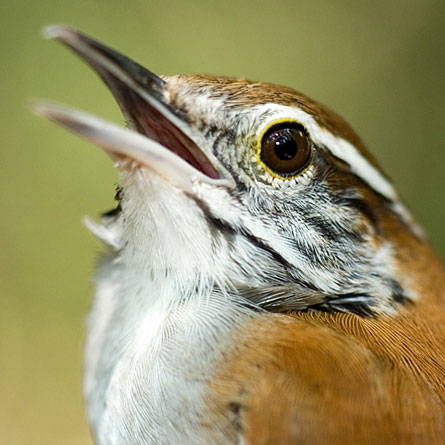When partners mingle music, it’s war. Or sometimes it’s just trying to find each other in all those bushes.
A new technique for locating birds by their songs shows that duets have their uses in both war and peace, according to a study to appear in the upcoming Current Biology.
Certain animals, particularly tropical bird species, sing duets much as people do, coordinating, interspersing and overlapping musical phrases. These aren’t the oh-yeah-says-who competitive singing bouts between rival males. A mated pair sings these duets, sometimes alternating parts so precisely they sound like one bird.
Biologists have come up with plenty of theories to explain the functions for these remarkable performances. Testing the ideas has been difficult though, because so many of dueting species live in dense forests that foil behavioral observations.
To study birds in these tangles, Daniel Mennill of the University of Windsor in Canada and Sandra Vehrencamp of Cornell University are the first researchers to deploy microphone arrays in forests to triangulate the positions of singing birds based on their sounds. Locating the singing partners and tracking how they move during a duet gives clues to the music’s functions.
In Costa Rica, the team tracked dueting rufous-and-white wrens, Thryothorus rufalbus. The partners often sang overlapping phrases while separated by as much as 140 meters in their dense, forested home. When dueting far apart, partners tended to move closer to each other.
This kind of dueting supports the idea that duets allow two birds to keep in touch or find each other. Mennill compares it to the game of Marco Polo, where a searcher calls out “Marco” and moves toward the searchee’s answering call of “Polo.”
Those “where are you” moments weren’t the only duets, though. Birds sang together when they perched side-by-side. So to test for other functions, the researchers played recordings that simulated duets from another pair of wrens, as if the neighbors were invading the real-world pair’s territory. The residents burst out dueting, singing five-fold more of their joint songs per minute than they had before the intrusion. This rise, the researchers say, supports the theory that a good duet is a good defense.

|
|
|
| |
|
|
JAZZIER SPECIES
Play to hear a pair of rufous-and-white wrens overlapping parts in a duet. Sonogram presents sounds visually: male part in blue, female in red.
Credit: Mennill
|
| |
|
|
TIGHT DUO
Play to hear two plain wrens alternating to perform one song. Sonogram presents sounds visually: male part in blue, female in red.
Credit: Mennill






